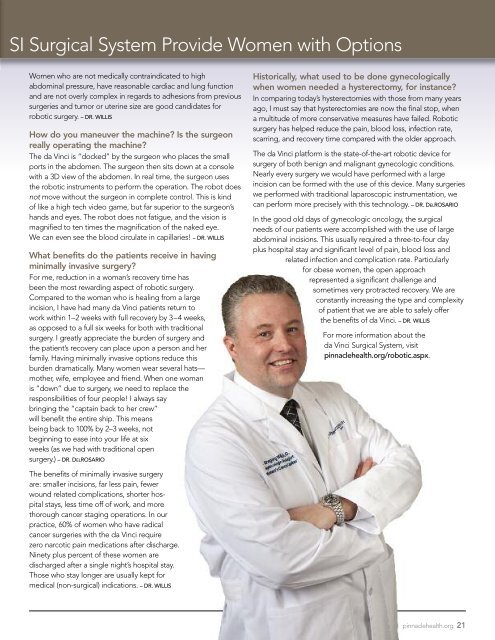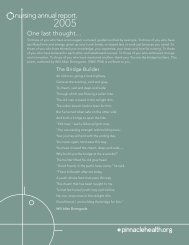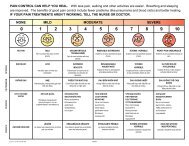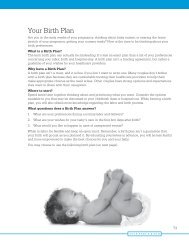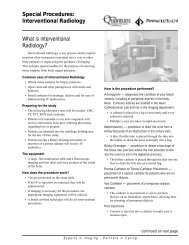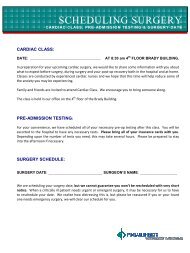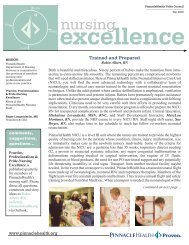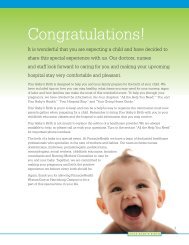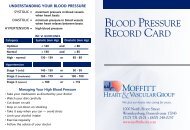Mary McCurdy - PinnacleHealth
Mary McCurdy - PinnacleHealth
Mary McCurdy - PinnacleHealth
You also want an ePaper? Increase the reach of your titles
YUMPU automatically turns print PDFs into web optimized ePapers that Google loves.
SI Surgical System Provide Women with Options<br />
Women who are not medically contraindicated to high<br />
abdominal pressure, have reasonable cardiac and lung function<br />
and are not overly complex in regards to adhesions from previous<br />
surgeries and tumor or uterine size are good candidates for<br />
robotic surgery. – DR. WILLIS<br />
How do you maneuver the machine Is the surgeon<br />
really operating the machine<br />
The da Vinci is “docked” by the surgeon who places the small<br />
ports in the abdomen. The surgeon then sits down at a console<br />
with a 3D view of the abdomen. In real time, the surgeon uses<br />
the robotic instruments to perform the operation. The robot does<br />
not move without the surgeon in complete control. This is kind<br />
of like a high tech video game, but far superior to the surgeon’s<br />
hands and eyes. The robot does not fatigue, and the vision is<br />
magnified to ten times the magnification of the naked eye.<br />
We can even see the blood circulate in capillaries! – DR. WILLIS<br />
What benefits do the patients receive in having<br />
minimally invasive surgery<br />
For me, reduction in a woman’s recovery time has<br />
been the most rewarding aspect of robotic surgery.<br />
Compared to the woman who is healing from a large<br />
incision, I have had many da Vinci patients return to<br />
work within 1–2 weeks with full recovery by 3–4 weeks,<br />
as opposed to a full six weeks for both with traditional<br />
surgery. I greatly appreciate the burden of surgery and<br />
the patient’s recovery can place upon a person and her<br />
family. Having minimally invasive options reduce this<br />
burden dramatically. Many women wear several hats—<br />
mother, wife, employee and friend. When one woman<br />
is “down” due to surgery, we need to replace the<br />
responsibilities of four people! I always say<br />
bringing the “captain back to her crew”<br />
will benefit the entire ship. This means<br />
being back to 100% by 2–3 weeks, not<br />
beginning to ease into your life at six<br />
weeks (as we had with traditional open<br />
surgery.) – DR. DELROSARIO<br />
The benefits of minimally invasive surgery<br />
are: smaller incisions, far less pain, fewer<br />
wound related complications, shorter hospital<br />
stays, less time off of work, and more<br />
thorough cancer staging operations. In our<br />
practice, 60% of women who have radical<br />
cancer surgeries with the da Vinci require<br />
zero narcotic pain medications after discharge.<br />
Ninety plus percent of these women are<br />
discharged after a single night’s hospital stay.<br />
Those who stay longer are usually kept for<br />
medical (non-surgical) indications. – DR. WILLIS<br />
Historically, what used to be done gynecologically<br />
when women needed a hysterectomy, for instance<br />
In comparing today’s hysterectomies with those from many years<br />
ago, I must say that hysterectomies are now the final stop, when<br />
a multitude of more conservative measures have failed. Robotic<br />
surgery has helped reduce the pain, blood loss, infection rate,<br />
scarring, and recovery time compared with the older approach.<br />
The da Vinci platform is the state-of-the-art robotic device for<br />
surgery of both benign and malignant gynecologic conditions.<br />
Nearly every surgery we would have performed with a large<br />
incision can be formed with the use of this device. Many surgeries<br />
we performed with traditional laparoscopic instrumentation, we<br />
can perform more precisely with this technology. – DR. DELROSARIO<br />
In the good old days of gynecologic oncology, the surgical<br />
needs of our patients were accomplished with the use of large<br />
abdominal incisions. This usually required a three-to-four day<br />
plus hospital stay and significant level of pain, blood loss and<br />
related infection and complication rate. Particularly<br />
for obese women, the open approach<br />
represented a significant challenge and<br />
sometimes very protracted recovery. We are<br />
constantly increasing the type and complexity<br />
of patient that we are able to safely offer<br />
the benefits of da Vinci. – DR. WILLIS<br />
For more information about the<br />
da Vinci Surgical System, visit<br />
pinnaclehealth.org/robotic.aspx.<br />
pinnaclehealth.org 21


